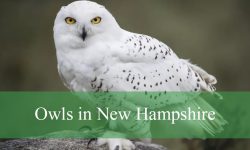Michigan’s forests, fields, and backyard feeders are alive with color throughout the year, and few sights are more striking than the red birds in Michigan. Their brilliant plumage stands out in every season, from snowy branches in winter to leafy treetops in summer. These birds bring both beauty and energy to the landscapes they inhabit.
Red birds in Michigan include a diverse mix of species, each with its own unique shade of red, preferred habitat, and seasonal pattern. Some, like the northern cardinal, are permanent residents, while others, like the scarlet tanager or common redpoll, appear only during certain times of the year. Spotting one can turn an ordinary day into a memorable birding moment.
This guide to 12 red birds in Michigan offers detailed identification tips, fun facts, and insights into their behaviors and distribution. Learning to recognize these birds adds a new level of enjoyment to birdwatching across the state, from urban parks to quiet forest trails.
Common Red Birds Found in Michigan
Northern Cardinal (Cardinalis cardinalis)
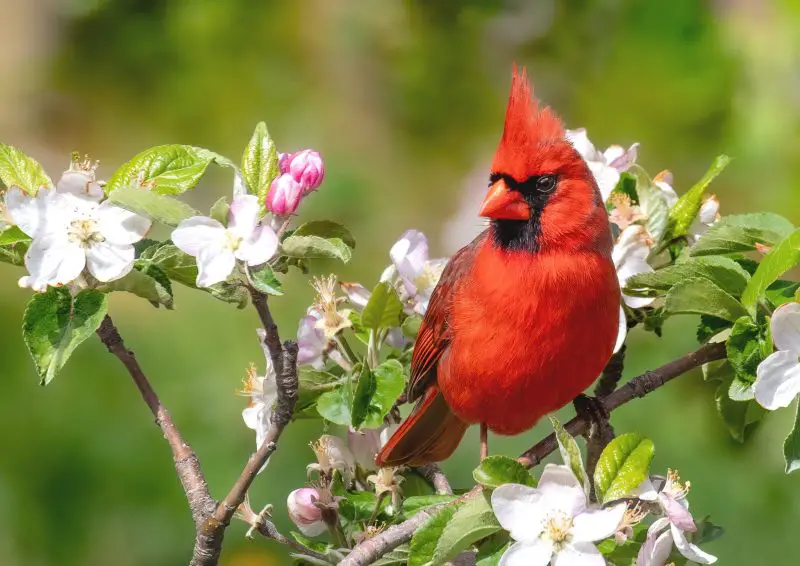
The Northern Cardinal is one of the most recognizable birds in Michigan due to its vivid coloration and melodic songs. Males are a brilliant crimson red all over, with a contrasting black mask around the face that extends from the beak to the throat. Females are more subdued, sporting warm brown feathers tinged with red on the crest, wings, and tail. Both sexes have a distinctive crest atop their head and a thick, orange-red conical beak that is well-suited for cracking seeds.
These birds measure about 8.3 to 9.1 inches in length with a wingspan around 10 to 12 inches. They are non-migratory and can be spotted year-round throughout Michigan, from woodlands and suburban backyards to city parks. Cardinals are particularly fond of sunflower seeds and will readily visit feeders, especially in winter when natural food sources are scarce. Their loud, whistling songs are a familiar sound during the warmer months.
Behaviorally, cardinals are territorial during the breeding season and are often seen chasing intruders away from their nest area. They may even attack their own reflection, mistaking it for a rival. Males are attentive mates, often feeding the females beak-to-beak during courtship. Pairs usually raise multiple broods each year, building cup-shaped nests in dense shrubs or low tree branches.
A fun fact about the Northern Cardinal is that it was named after the red robes worn by Roman Catholic cardinals. In Michigan, their population remains stable, and they are frequently highlighted in winter bird counts due to their bright contrast against the snow-covered landscape.
House Finch (Haemorhous mexicanus)
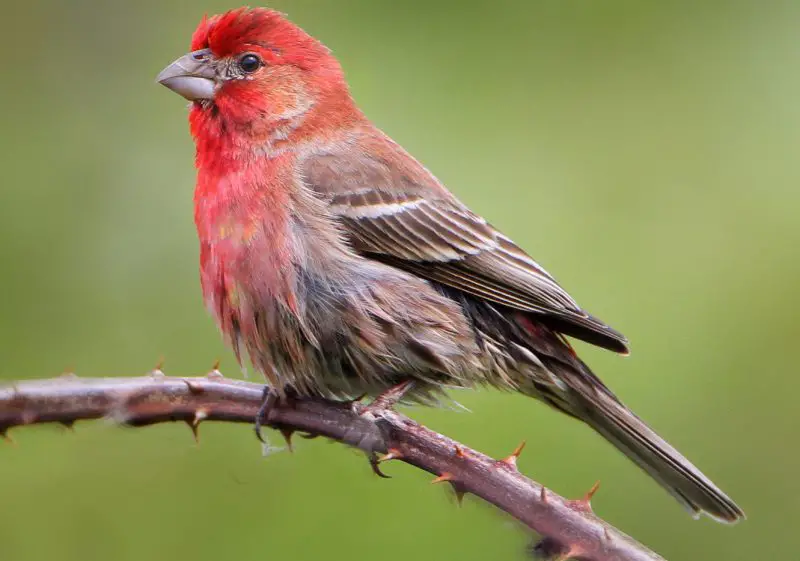
The House Finch is a small, adaptable songbird that has successfully expanded its range across much of North America, including Michigan. Males display a rosy-red coloration on the forehead, throat, and chest, which may vary in intensity depending on diet. Females lack the red and are streaked brown and white throughout, making them more cryptic in appearance. Both sexes have a slender body, a short notched tail, and a slightly curved beak designed for eating seeds and fruit.
House Finches are about 5 to 6 inches in length with a wingspan around 8 to 10 inches. They are common year-round residents throughout Michigan, particularly in cities, suburbs, and farmlands. These birds are often seen perching on wires, foraging on the ground, or visiting backyard feeders where they favor sunflower seeds and millet. Their pleasant, warbling song can often be heard from rooftops and treetops.
Social and gregarious, House Finches often forage in small flocks, especially outside the breeding season. They build messy cup-shaped nests in a variety of sheltered spots, including hanging planters, ledges, and light fixtures. Unlike many native species, House Finches are cavity-nesting generalists, which helps them thrive in human-modified environments.
Interestingly, House Finches were originally native only to the western United States and Mexico. They were introduced to the eastern U.S. in the 1940s and rapidly spread. In Michigan, they’re now widespread, especially in the southern and central parts of the state. They can be mistaken for the Purple Finch, though their red coloring is more orange-red and localized to the head and upper chest.
Purple Finch (Haemorhous purpureus)
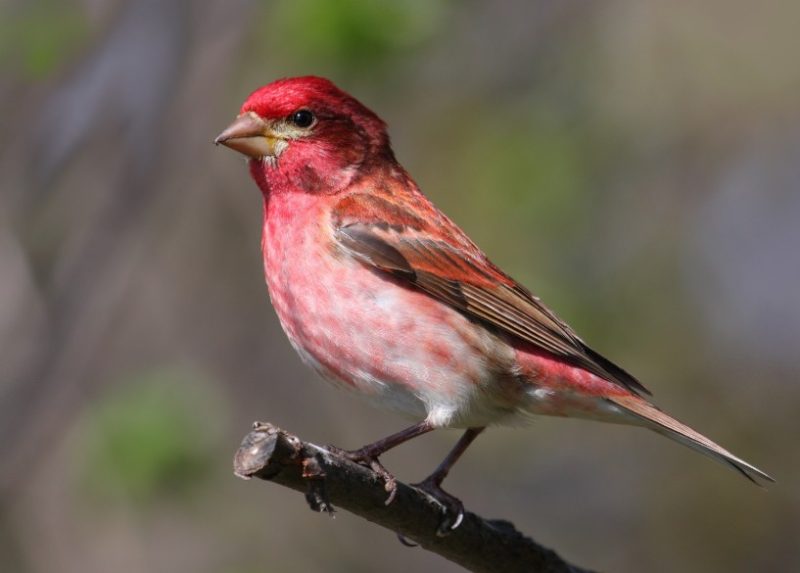
The Purple Finch is a striking bird whose name can be misleading—it isn’t truly purple. Males are a deep raspberry-red, with the brightest hues on the head, chest, and back, blending into streaked brown wings and tail. Females, by contrast, are brown and heavily streaked with a bold white stripe above the eye, giving them a distinctive face pattern. Both sexes have a sturdy, seed-cracking bill and are slightly chunkier than the House Finch.
Measuring about 6 inches in length with a wingspan between 8.5 and 10 inches, Purple Finches are a bit stockier and heavier-billed than their House Finch cousins. In Michigan, they are more commonly seen in the northern parts of the state and the Upper Peninsula. While some individuals overwinter, many are migratory and pass through the region during spring and fall migrations, especially in forested areas and woodsy backyards.
These finches prefer coniferous and mixed forests during the breeding season, where they build their nests in trees, often well-hidden among branches. During migration and winter, they are more flexible, visiting feeders and feeding on seeds, berries, and buds. Their song is a rich, melodious warble, often described as sweeter and more fluid than that of the House Finch.
A fun fact is that the Purple Finch is the state bird of New Hampshire. In Michigan, birdwatchers often await their brief spring visits with anticipation, especially in areas with mature trees and quiet neighborhoods. Their less aggressive behavior and rarer presence make them a delight for seasoned birders.
Scarlet Tanager (Piranga olivacea)

The Scarlet Tanager is one of the most breathtaking birds found in Michigan’s woodlands during summer. The adult male is brilliantly colored with deep scarlet-red plumage and jet-black wings and tail, creating a sharp, unforgettable contrast. Females and immature males are entirely different in appearance, featuring olive-yellow upperparts and dusky wings. Their medium-sized, stout bill is ideal for eating insects and fruit.
Scarlet Tanagers are around 6.3 to 7.5 inches long with wingspans of about 11 to 12 inches. They are migratory and typically arrive in Michigan in late spring, remaining through the summer to breed. Their preferred habitat includes mature deciduous forests, especially those dominated by oak, maple, and beech. They spend most of their time in the canopy, making them more often heard than seen.
Despite their dazzling colors, Scarlet Tanagers can be surprisingly elusive. They forage quietly for insects among the leaves or sing their distinctive, robin-like song—a series of rich, burry phrases often likened to a robin with a sore throat. They also eat fruit and berries, particularly in late summer before migration. Females build nests high in trees, where they lay 3–5 pale eggs.
A fascinating fact about Scarlet Tanagers is their long migration journey—they winter in the Amazon Basin of South America. In Michigan, they are mostly found in the Lower Peninsula’s forested regions and along woodland edges. Conservation of mature forest habitats is vital to ensure their continued presence in the state each year.
Summer Tanager (Piranga rubra)
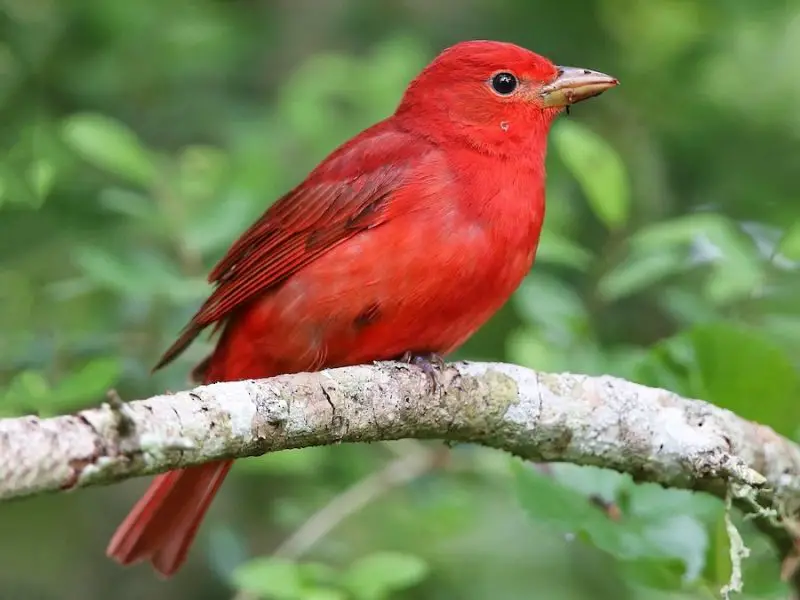
The Summer Tanager is the only completely red bird in North America, and adult males are truly striking with their uniform red plumage and large, slightly curved bill. Females, in contrast, are mustard yellow to golden-olive and may show a faint orange tinge in certain lights. Juvenile males may appear mottled red and yellow as they transition to their adult colors. This species is a member of the cardinal family, though its behavior and habitat preferences differ somewhat.
Summer Tanagers are about 6.7 inches long with a wingspan of approximately 11 inches. In Michigan, they are not common breeders but are occasionally spotted in the southern part of the state during spring and fall migration. Their preferred breeding range lies further south, but sightings have been increasing in recent years, possibly due to shifting climate conditions and habitat changes.
These birds are insectivorous and particularly fond of bees and wasps, which they catch mid-air or glean from foliage. Their strong bill allows them to remove stingers before consuming their prey. They also eat fruit, especially during migration. Summer Tanagers typically stay high in the canopy, making them harder to observe despite their vibrant coloring.
A fun fact: because of their fondness for bees and wasps, they are sometimes nicknamed “bee birds.” In Michigan, birders consider spotting a Summer Tanager a special treat, especially in southern counties such as Berrien, Washtenaw, or Kalamazoo, where they occasionally appear in May or September.
Red Crossbill (Loxia curvirostra)

The Red Crossbill is a unique and specialized finch known for its odd-looking, crossed mandibles, which it uses expertly to pry open conifer cones. Adult males are brick-red to orange-red with darker wings, while females are yellowish or olive-gray. Their distinctive bill shape and heavy body help differentiate them from other finches, especially when seen feeding in pine trees.
These birds are about 5.5 to 6.5 inches long with a wingspan of 10 to 11 inches. Red Crossbills are erratic visitors in Michigan, showing up primarily in the Upper Peninsula and northern Lower Peninsula, especially during irruption years when food is scarce farther north. They prefer coniferous forests dominated by spruce, pine, or hemlock, where cone crops are abundant.
Behaviorally, Red Crossbills are highly nomadic and may breed at almost any time of year, depending on food availability. They travel in flocks, often giving sharp “jip-jip” calls in flight. Their specialized diet means they are closely tied to cone production cycles, making their presence in Michigan unpredictable. They will sometimes visit feeders for sunflower seeds, especially in winter.
A fun fact about this species is that there are several “types” or vocal variants of Red Crossbills across North America, and each may prefer a specific type of conifer cone. In Michigan, sightings are most reliable in winter in heavily forested regions such as the Huron-Manistee National Forest or Ottawa National Forest.
Common Redpoll (Acanthis flammea)
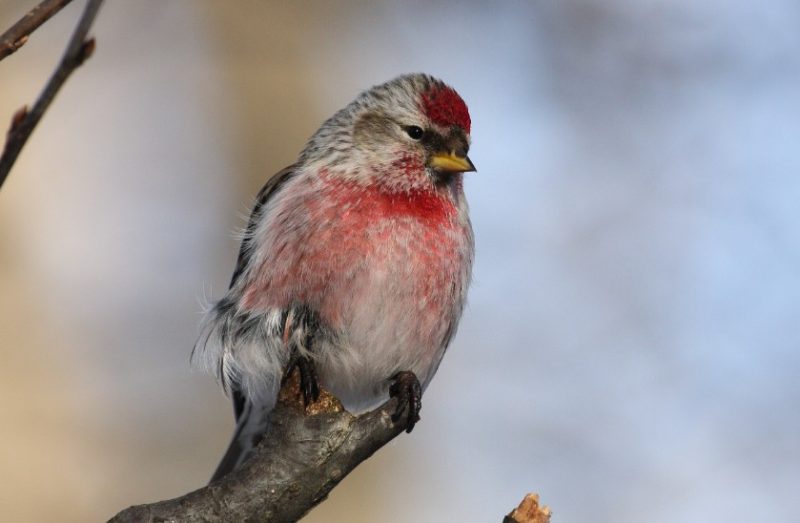
The Common Redpoll is a small, hardy finch that visits Michigan primarily during the colder months. These birds are instantly recognizable by the bright red patch on their forehead, black chin, and heavily streaked brown and white bodies. Adult males often show a faint rosy wash on the chest, while females typically lack the pink but retain the red forehead. Their tiny, pointed bills and notched tails complete the classic redpoll look.
Measuring just 4.7 to 5.5 inches in length with a wingspan of around 7.5 to 8.7 inches, Common Redpolls are compact and agile fliers. They breed in the Arctic tundra but migrate south in winter, sometimes arriving in large numbers during irruption years when seed crops fail in the north. In Michigan, they are regular winter visitors, especially in the Upper Peninsula and northern Lower Peninsula, frequenting weedy fields, open woodlands, and backyard feeders.
These birds are very social and often travel in active flocks that chatter constantly as they feed. They are particularly fond of birch, alder, and thistle seeds, and will readily visit nyjer feeders during the snowy months. Redpolls are also known to forage acrobatically, hanging upside down to reach seeds from slender twigs or feeders. They have dense plumage and even throat pouches to store food in frigid temperatures.
A fun fact: Common Redpolls can survive temperatures as low as -65°F thanks to their excellent insulation and ability to burrow into snow for shelter. In Michigan, they add welcome movement and color to the winter landscape, offering a treat to birders and backyard observers alike.
Cassin’s Finch (Haemorhous cassinii)
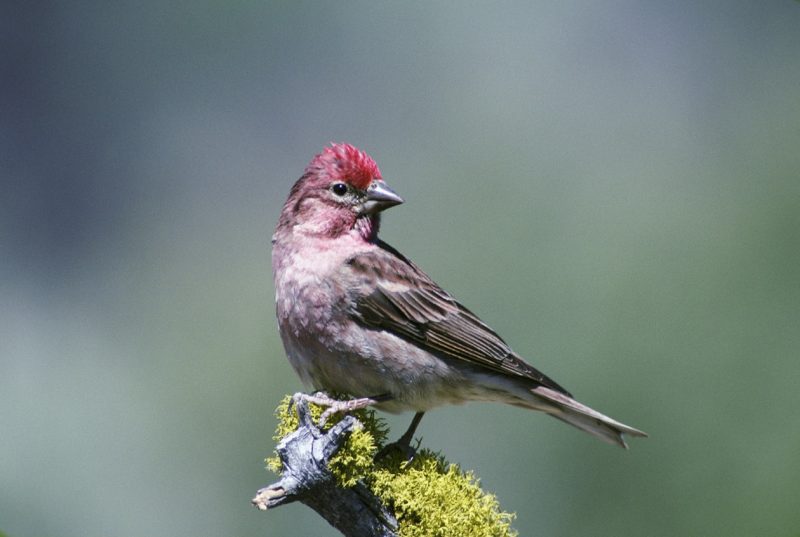
Cassin’s Finch is a rare and exciting sighting in Michigan, typically appearing only during irruption events. Males are distinguished by a bright rosy-red crown, throat, and upper breast that gradually blends into a streaked brown back and wings. Females lack the red altogether and appear as finely streaked brown birds with a subtle facial pattern. Their overall shape is more elongated compared to House or Purple Finches, with a heavier bill and longer tail.
These birds are about 6.3 inches in length with a wingspan of approximately 9.5 to 10.5 inches. Cassin’s Finches are native to the mountainous West, breeding in high-elevation conifer forests. They seldom stray eastward, but when cone crops fail or conditions are suitable, a few individuals may venture into Michigan, particularly during winter months or transitional periods like early spring.
Unlike the Purple Finch’s more saturated raspberry tones, the Cassin’s Finch’s red is limited to the top and front of the male’s head and chest. They are ground foragers and often feed on seeds, buds, and berries. When visiting feeders, they may be mistaken for other red finch species, though subtle differences in bill shape and song can help with identification.
A fun and challenging aspect of birding is distinguishing Cassin’s Finch from other red finches in the region. In Michigan, they are considered rare vagrants, with most sightings reported in the southern half of the Lower Peninsula during irruptive winters. These appearances often spark interest among the birding community.
Vermilion Flycatcher (Pyrocephalus obscurus)
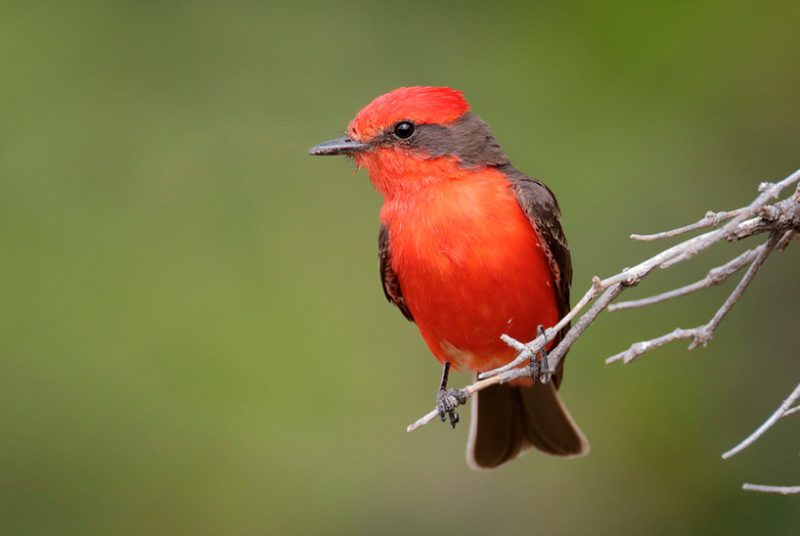
The Vermilion Flycatcher is one of the most vividly colored birds in North America, and its appearance in Michigan is a rare but thrilling event. Males are stunning with brilliant red plumage covering the underparts and crown, sharply contrasted by dark brown to black wings, back, and tail. Females are more subdued with grayish upperparts and pale bellies washed with peach or salmon hues. Their compact bodies and short tails give them a perky silhouette.
Measuring around 5.1 to 5.5 inches in length with a wingspan of about 9.4 inches, Vermilion Flycatchers are typically found in the southwestern U.S., Mexico, and Central America. In Michigan, sightings are extremely rare and usually occur in late fall or spring, often involving young or dispersing individuals that stray far outside their usual range. Such vagrants are often spotted in open habitats like fields, brushy clearings, or near lakeshores.
As flycatchers, these birds hunt insects in mid-air with darting sallies from exposed perches. They are typically solitary or found in pairs and exhibit bold aerial displays during breeding in their native range. While they do not breed in Michigan, a surprise appearance by a male Vermilion Flycatcher can cause a birding frenzy among local enthusiasts.
A fun fact: Vermilion Flycatchers are part of the tyrant flycatcher family, known for their aggressive foraging techniques. In Michigan, one was famously seen near a wastewater treatment plant—proving that rare beauty can show up in the most unexpected places.
Red-headed Woodpecker (Melanerpes erythrocephalus)

The Red-headed Woodpecker is a striking bird with a bold color scheme that makes it instantly recognizable. Adults display a brilliant crimson-red head, snow-white underparts, and a sharp contrast of black-and-white wings. Unlike many woodpecker species, both sexes look identical. Juveniles, however, are drabber, with brownish heads and mottled backs. Their medium-length chisel-like bill is strong and suited for hammering into wood or catching flying insects.
This species is about 7.5 to 9.1 inches long with a wingspan around 16 to 17 inches. In Michigan, Red-headed Woodpeckers are most frequently found in the southern Lower Peninsula, particularly in open woodlands, oak savannas, and near forest edges. They prefer areas with dead trees or snags, which they use for nesting and storing food. Their presence in the state has declined due to habitat loss, but they are still locally common in suitable areas.
Unlike most woodpeckers, Red-headed Woodpeckers are skilled aerial hunters, often catching insects in mid-air. They also store food in tree crevices, a behavior known as “caching,” which includes seeds, nuts, and even live grasshoppers. These birds are cavity nesters and are known to be highly territorial during the breeding season.
A fascinating trait of this species is their role in folklore and Native American symbolism, where they were admired for their fierce nature. In Michigan, their flashy plumage and rare but localized distribution make them a prized species for birders exploring oak woodlands and nature preserves.
Red-bellied Woodpecker (Melanerpes carolinus)
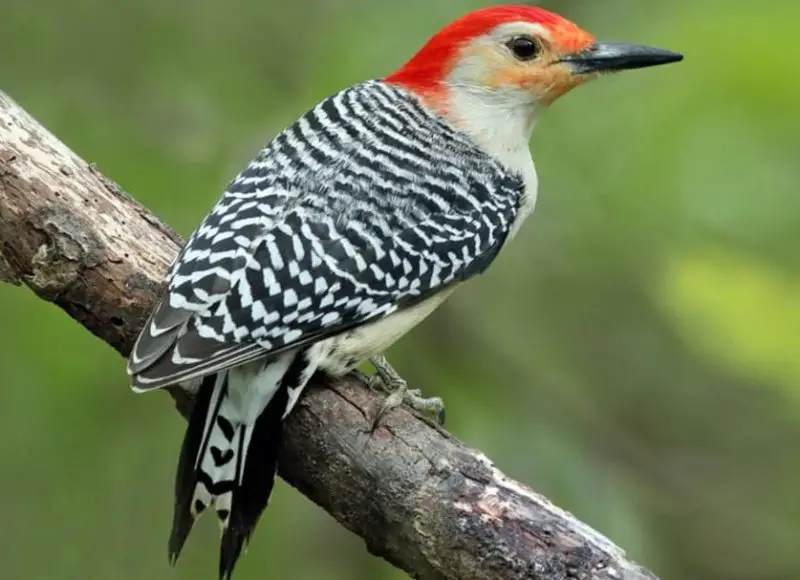
Despite its name, the Red-bellied Woodpecker is more notable for the red coloring on its head than its faint reddish belly, which is often hard to see. Males have red extending from the bill to the nape, while females show red only on the nape and back of the neck. Their backs are barred with black and white zebra-like patterns, and their pale bellies sometimes have a pinkish wash. Their long, sticky tongues are well adapted for extracting insects from crevices.
These woodpeckers are medium-sized, measuring about 9.4 inches long with a wingspan of 13 to 16.5 inches. In Michigan, they are common residents, especially in the southern and central regions. They inhabit deciduous forests, wooded suburbs, and parks, and they often visit backyard feeders, especially those offering suet or peanuts.
Red-bellied Woodpeckers are active and vocal, known for their rolling “churr” calls and drumming sounds on tree trunks or utility poles. They feed on a wide variety of foods, including insects, fruits, nuts, and seeds. Their agility allows them to climb tree trunks vertically or hop sideways with ease. Nesting typically occurs in dead tree cavities, where they raise one brood per season.
A fun fact: Red-bellied Woodpeckers are expanding their range northward, possibly due to warmer winters and increased tree cover in formerly open lands. In Michigan, their growing presence reflects broader ecological shifts, making them a familiar and welcome sight across many regions of the state.
American Robin (Turdus migratorius)
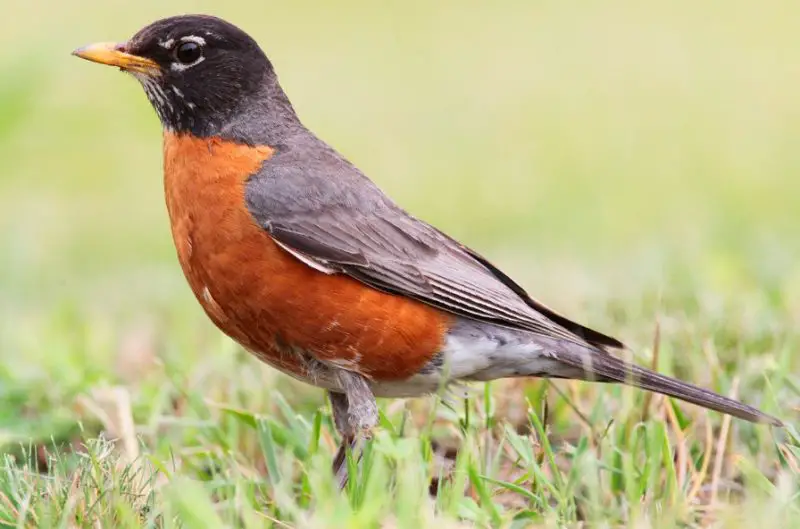
The American Robin is perhaps the most familiar bird in Michigan and is celebrated as the state bird. Though not entirely red, its rich reddish-orange breast is its most recognizable feature. The rest of the body is grayish on the back with a white lower belly and tail corners. Males are typically more vividly colored than females, but both share the same general appearance. Their yellow beak and white eye ring help complete the ID.
Robins are medium-sized songbirds, measuring about 9 to 11 inches in length with a wingspan of 12 to 16 inches. They are year-round residents in parts of Michigan, though many individuals migrate south in winter and return in spring. Their arrival is often seen as a harbinger of spring, especially when they begin singing their cheerful, flute-like songs from treetops and rooftops.
These birds are versatile and adaptable, inhabiting suburban lawns, forests, farmlands, and city parks. They feed on earthworms, insects, and fruit, often seen hopping across the grass and cocking their heads to locate prey. During the breeding season, robins build nests from mud and grass, usually on ledges or in tree branches, raising two to three broods per year.
A charming fact: American Robins are among the first birds to sing in the morning, often beginning their chorus well before dawn. In Michigan, their prominence in all seasons and habitats makes them an emblem of the changing seasons and a beloved presence for residents statewide.
FAQ About Red Birds in Michigan
What is the most common red bird in Michigan?
The most common red bird in Michigan is the northern cardinal. It is a year-round resident across the state and is easily recognized by its vivid red color, black facial mask, and melodious song. Cardinals are frequently seen at backyard feeders, woodlands, and suburban areas.
Are red birds in Michigan only seen in summer?
No, not all red birds in Michigan are summer visitors. While some species like the scarlet tanager and summer tanager appear only during the warmer months, others such as the northern cardinal, house finch, and red-bellied woodpecker can be seen year-round. Common redpolls are winter visitors.
How can I attract red birds to my backyard in Michigan?
To attract red birds, offer food like black oil sunflower seeds, suet, and nyjer seeds. Planting native shrubs and trees, providing water sources, and leaving some natural areas undisturbed can also help. Cardinals, house finches, and red-bellied woodpeckers are especially attracted to feeders.
What’s the difference between house finch and purple finch in Michigan?
Though similar, house finches have a more orange-red coloration limited to the head and chest, while purple finches have a raspberry-red hue that extends over more of the body. Purple finches are more common in northern Michigan or during migration, whereas house finches are widespread year-round.
Are there any rare red birds found in Michigan?
Yes, several red birds are considered rare in Michigan. These include the vermilion flycatcher, which is an occasional vagrant, and the Cassin’s finch, which appears during irruption years. These birds are not commonly seen but can show up unexpectedly, especially during unusual migration patterns.
Is the American robin considered a red bird?
While not entirely red, the American robin has a prominent reddish-orange breast and is often included in lists of red birds. It is also Michigan’s state bird and a familiar sight across the state, especially in spring and summer.
Where are the best places to see red birds in Michigan?
Red birds can be seen statewide, but some hotspots include southern woodlands for red-headed woodpeckers and tanagers, northern forests for purple finches and red crossbills, and suburban areas for cardinals and house finches. Nature preserves and parks are excellent locations for spotting both common and rare species.




